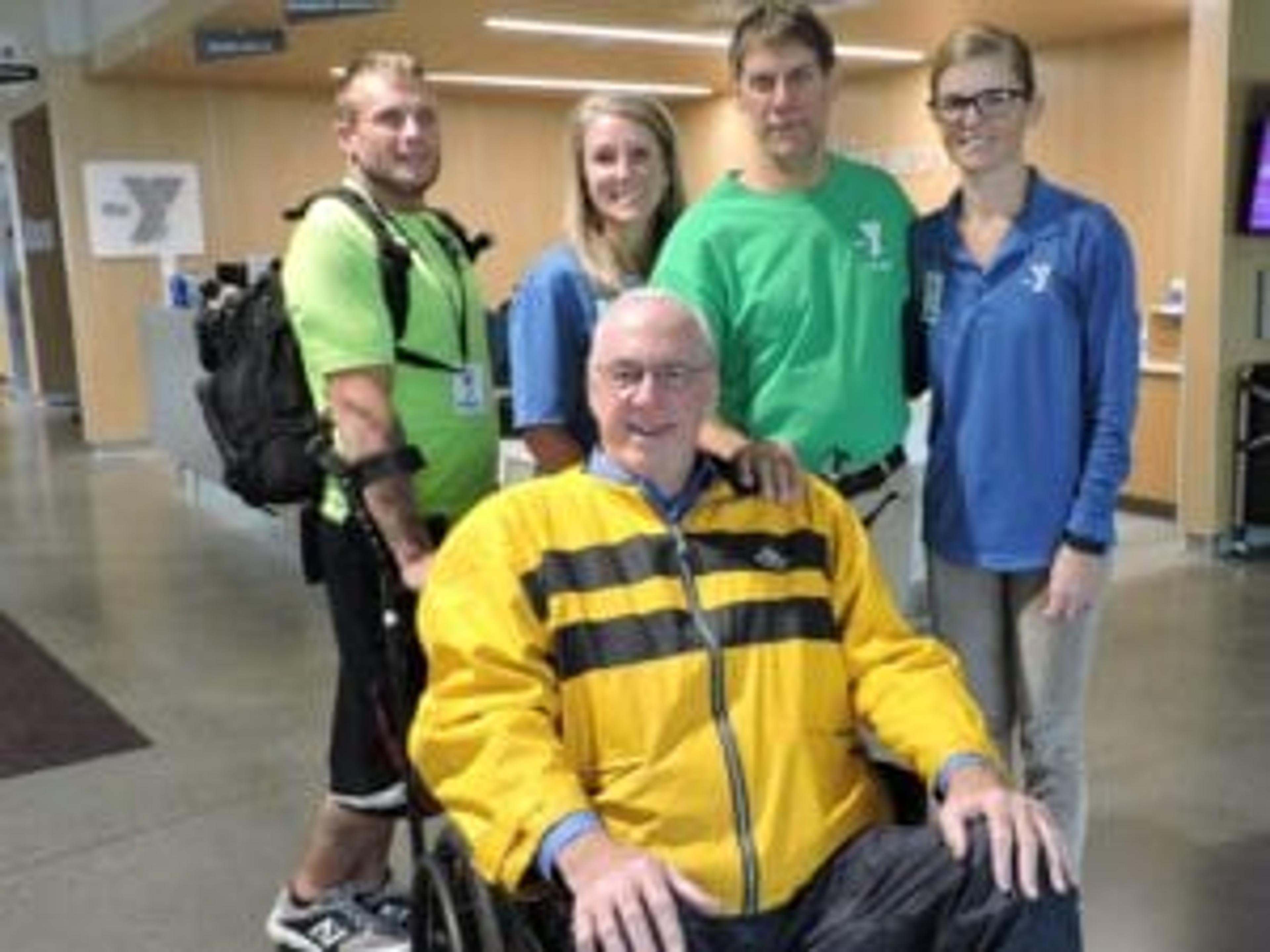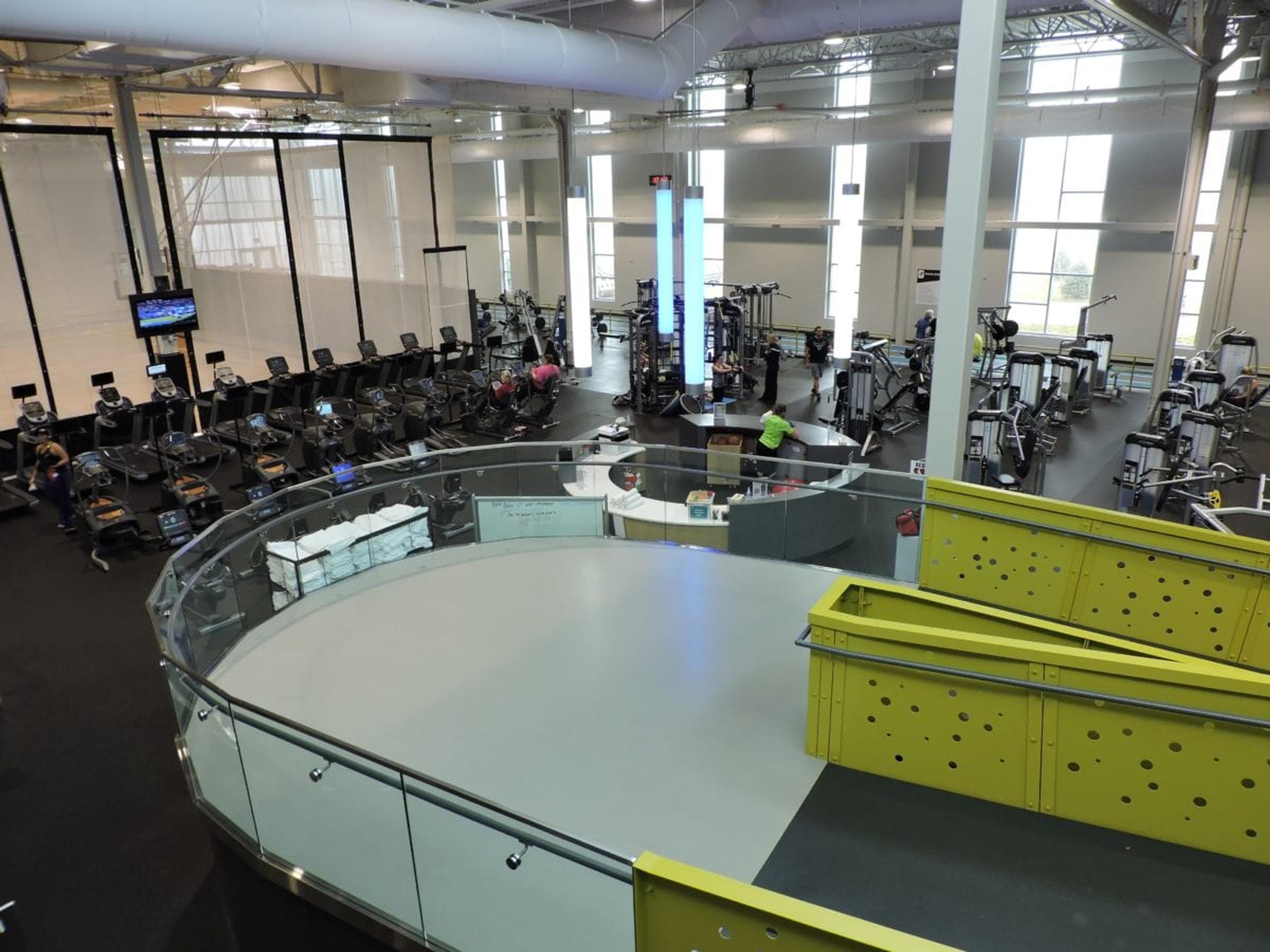Designed With Everyone in Mind: West Michigan YMCA Accessible for All

Julie Bitely
| 5 min read

Paul Hayes likes to work out and that didn’t change when he was diagnosed with muscular dystrophy in 2009.

Paul Hayes and some of the Mary Free Bed YMCA staff.
As the disease progressed, Hayes relied on a walker and now mostly gets around in his wheelchair. The 64-year-old’s workout locale of choice over the past year has been the Mary Free Bed YMCA, located in Cascade Township, near southeast Grand Rapids. Hayes alternates his workouts between the pool and the ample cardio and weight machines.
The facility is the first in the world to earn a global universal design certification from the Global Universal Design Commission. Simply put, the designation recognizes that the building was designed with everyone in mind. Throughout the design process, a range of populations and their needs were considered, from aging users, special-needs children, those with a temporary sports injury or people recovering from medical procedures, to individuals with muscular skeletal diseases and those with hearing and sight challenges.
As you enter, a long, gently sloping ramp is the first visual indication that the facility is welcoming to all, but if you weren’t looking, you might not immediately realize all the details that go into making it as accessible as possible.

Workout areas and equipment are designed and spaced to allow for wheelchairs to freely pass through. Many of the weight machines can be used by wheelchair and walker users. There are a large number of family changing rooms with sit-down showers, which can allow for greater ease of use. Hand rails are plentiful. The font on signage throughout the facility is larger to help those with visual disabilities better navigate the facility. Read more about some of the hidden-in-plain-sight accessibility highlights here.
“When you’re here and it’s just sort of a normal environment – that’s very hopeful to someone who is disabled,” Hayes explained.

Before the facility became reality, he saw a future that he knew might include moving his workouts to more of a medical setting, which would have been a “huge loss” in his eyes.
“I think it’s being involved in the human race, for one thing,” he said. “You like to see people interacting and connecting at different levels and you get to see that here.”
Built to Evolve
Andy Page is Chief Operating Officer for the YMCA of Greater Grand Rapids. He said the Mary Free Bed facility has been embraced by the community since it opened. Enrollment is strong and people of all ability levels have made it their workout destination.
“We’ve seen a very diversified membership base,” Page said.
The journey to become a certified universal design facility was long and continues to be a work in progress. Being the first means there was no clearly identified road map to follow and Page said staff knew changes would have to be made as people started using the facility.

Members can suggest improvements through a suggestion box, while a facility improvement task force meets quarterly to evaluate how the facility is working to meet member needs and to identify any necessary adjustments and changes. Hayes is a task force member.
“They have processes set up to get feedback, they listen to it and they act on it,” Hayes said.
He became a task force member after he pointed out some layout adjustments and safety improvements he felt would be beneficial. As he’s adjusted to life with a disability, Hayes said he notices the placement of everyday things like door-opening buttons and soap dispensers with new eyes. The slope of a ramp can make the difference between a building being accessible or not.
Being a pioneer in universal design means everything at the Y wasn’t perfect the first day, but Hayes is optimistic that other facilities around the country can learn and benefit from what has been accomplished.
“It’s a superior facility, no doubt about it,” he said.
Page said staff from about 10 other YMCA facilities from as far away as Hawaii have visited to see how they can implement universal design principles into their upcoming projects. He predicts that eventually, universal design certification will be as mainstream as LEED certification is now, another designation the facility boasts.

“Providing accessible amenities doesn’t deter able-bodied individuals, so why wouldn’t we,” he said.
People Make the Place
As much as the physical building is designed for everyone, equal attention is paid to the people who work there. Staff at the Y represent the population they serve, Page said. Special care goes into hiring professionals of all ability levels.
Hayes thinks the inclusion sends a strong message of leadership and welcome to people like him. While the building ensures everyone has access, it’s the people that ultimately make it a warm and inviting space.
“I know a lot of them and I’ve never met one that didn’t represent the YMCA very well and wasn’t highly customer focused,” he said.
On a recent Tuesday afternoon, Hayes was greeted heartily by name as he wheeled past the front desk. You can tell he finds this Y to be a special place where he and others can fully belong.
“It’s good for both normal people and disabled people to have that side-by-side interaction,” he said.
If you liked this post, you might also enjoy:
Photo credit: Julie Bitely





